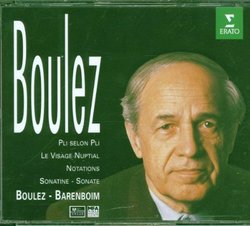| All Artists: Pierre Boulez, Phyllis Byrn-Julson, BBC Singers, BBC Symphony Orchestra, Elizabeth Laurence, Jeannne Marie Conquer Title: Boulez: Pli selon Pli / Le Visage Nuptial / Notations / Sonatine / Sonate / Boulez / Barenboim Members Wishing: 2 Total Copies: 0 Label: Warner Classics UK Release Date: 8/17/2005 Album Type: Import, Box set Genres: Pop, Classical Styles: Vocal Pop, Opera & Classical Vocal, Chamber Music, Forms & Genres, Concertos, Sonatas, Historical Periods, Modern, 20th, & 21st Century, Instruments, Reeds & Winds, Strings Number of Discs: 4 SwapaCD Credits: 4 UPC: 745099849528 |
Search - Pierre Boulez, Phyllis Byrn-Julson, BBC Singers :: Boulez: Pli selon Pli / Le Visage Nuptial / Notations / Sonatine / Sonate / Boulez / Barenboim
 | Pierre Boulez, Phyllis Byrn-Julson, BBC Singers Boulez: Pli selon Pli / Le Visage Nuptial / Notations / Sonatine / Sonate / Boulez / Barenboim Genres: Pop, Classical
|
Larger Image |
CD DetailsSimilar CDs
|
CD ReviewsBoulez-iana Fest scarecrow | Chicago, Illinois United States | 02/19/2005 (5 out of 5 stars) "Here it is all in one place,primarily the young and middle period Boulez. There's nothing comparable to early Boulez, here you can sense like a shark smells blood of an open animal miles away,the fresh scent of the new dodecaphopnic means of composition, a new language to be practiced now that the darkest pages of European history are behind, a pathway now inevitable unalterable,we see this in the "Le visage nuptial, and the "Le Soleil Des Eaux" after text by Rene Char intensifies this period with such powerful quasi-political texts of human suffering and the glories of the imagination.The smaplings of texts and timbre married forever here. Boulez perhaps would revise the densely compact orchestration, but the full throttle of gutsy timbre is there, divisi strings, large arrays of metal percussion (A French trademark,shibboleths),impacted winds in fast filigree work. I tend to not like what Boulez does to the voice,and find myself simply enjoying the breathtaking orchestrations it(the voice)in Boulez's hands is hardly sensual for any length of time,and it has a one-dimensioanl aspect about it(simply compare the timbral pallette Berio had utilized at the same timein Epihanies for example) it is treated as simply another instrument as a vehicle, a conduit for text, and the delivery with large amounts of vibrato is horribly wrong-headed. All these recordings are from other places, and you perhaps have already their presence in your collection. The"pli selon pli" is rather dated with Phyllis-Bryn Julson,joined in" Le visage. . " by Elizabeth Laurence with the BBC,Bouleaz first assignment there under Wm Glock's instigations. I would like to hear other recordings but there are none of "Le visage. . " and Les Soliel des Eaux". Barenboim as conductor continues to be somewhat tedious with Boulez, it takes him forever to learn the modernist repertoire, and seldom programs ant pieces that would give him the performative technique he needs,any Webern or Schonberg, or Berg, or Ligeti,nothing (only Elliott Carter) who I suspect he thinks he comprehends with greater depth of cognition. Here the"Rituel" requires a conductor who can see the freedoms in the music, with the elaborate array of cueing devices and changes of tempi Boulez had built into this piece for his own indulgences, and performative sense. The "Notations" we have all heard now countless times, there is even Boulez in rehearsal with Vienna Phil that is quite educative and probing,more so than a performance with Barenboim. Aimard plays the hell out of the First Piano Sonata, long a work in the shadow of the colossolly violent brutal Second Sonata, and indeterminate,elegant enigmatic Third Sonata. The First has two ideas; the sustained timbre and the pointillistic one, there are also intervallic magnetic forces that come to define regions in the work and points of a transgression to noise,in gradation; likewise the Flute Sonatine is cut from the same field,only if played well and violent, as it is here, the innovative modernity of the work has no equal, and really I tire to find another work for Flute anhd Piano that compares with the structural and aesthetic magnitude of this work, like I said early Boulez has fascinating moments. This is one of them. Much later now "Derive" is a minor work for a motley collection of flute, clarinet, piano, vibes, violin and violoncello seems weak by comparison, it is difficult to play and this is perhaps the best recording with Boulez Ensemble Intercontemporain Players, likewise Memoriale, as (explosante/fix) is a process work for Flute and 8 Instruments when Boulez began thinking of the live dimension with the aid of the 4X Computer to be developed further in the bowels of IRCAM, as the haunting "Dialogue de l'ombre double, an antiphonal work with clarinet which to me is the last interesting work that mines the challenge of live/altered electronics; the Antiphones with Violin and Antiphonal electronics is quite tedious, tame and boring. The "Dialogue. . ." essentially captures the timbres of the Clarinet which can be quite introspective, private, as well as strident in the upper registers.It is after a text of Paul Claudel,and as we know literature has beeen an enternal nourishment within the Boulez aesthetic." A nice box set, but reissued at budget price in Warner's Ape Christopher Culver | 09/05/2006 (4 out of 5 stars) "This Erato box set of works by Pierre Boulez covers almost every phase of his career. With the exception of the "Notations" and "Messagequisse", conducted by Daniel Barenboim, the composer himself leads the BBC Symphony Orchestra or the Ensemble Intercontemporain in the large works, and two of his favourite performers tackle the smallest works. These recordings have been reissued in Warner Classics' budget line Apex, so they come quite cheaply if you look around.
I'm not too thrilled with "Pli selon pli" (1957-1962), Boulez's grand setting of Mallarme for soprano and orchestra, as it tends to drag on. Still, at least here and on the Sony disc he still conducts with a certain violence, while in his conducting of the recently revised version on a 2002 Deutsche Grammophon disc the piece just falls apart. The Sony recording with soprano Halina Lukomsa is the more agressive, but this recording with Phyllis Bryn-Julison is more subtle, and the final movement "Don" comes across more powerfully here. The "Sonatine" for flute and piano and the "Piano Sonata No. 1" are among Boulez's earliest acknowledged works, dating from 1946. The "Sonatine" is inspired by Schoenberg's "Chamber Symphony op. 9" in form and by Berg in its serial material, while both the "Sonatine" and the Piano Sonata find inspiration in Webern and Schoenberg for the virtuoso and "delirious" piano parts. The "Sonatine" is a rather unexciting work, I'd call it juvenalia even if Boulez thinks it worthy of preservation. However, the Piano Sonata No. 1 is a rich piece which displays new sides of itself on every listen. I quite enjoy Pierre-Laurent Aimard's performance here, it has a savagery to it unlike the methodical touch of Jumppanen or the nimbleness of Biret. "Le Visage nuptial" (1946, final version 1988-89) and "Le Soleil des eaux" (1947, final version 1965), settings of Rene Char for soprano, mezzo-soprano, choir and ensemble, really should be more widely known, since they are among Boulez's most accessible works with their Berg-like lushness and clear dramatic qualities. This collection is one of the few places to get them, which presents a good motivation to buy it. Ditto for "cummings ist der Dichter" for mixed choir and orchestra (1970), much more experimental (even with some aleatoric writing), but a beautifully savage work of modernism. "Figures-Doubles-Prismes" (1963/1968) was first conceived in 1957. Karlheinz Stockhausen was writing his famous piece "Gruppen" for three orchestras at the time, and Boulez was interested in the unorthodox arrangement of the performing ensemble. Boulez's own approach was to use a single orchestra but to mix its segments up, with brass and wind inside the string section, resulting in exotic combinations of timbre. The result is rather disappointing. Boulez still hasn't finished the piece in nearly a half-century, and listening to it one can immediately tell that it's still very much a sketch for something else. There's no especial difference between this and the Robertson recording on Naive. The "Notations" for orchestra--five so far (I-IV and VII)--expansions of twelve Webern-like piano miniatures written in 1945 while Boulez was still a student--are Boulez at his best, glittering textures, powerful crescendi, exciting glissandi; it's no wonder that many orchestras (such as the CSO) regularly play one or two of them to open their concerts.Still, I'm not too impressed with Barenboim's conducting, and I'd recommend that by Robertson on Naive. Having heard some bootleg recordings of Boulez conducting, I think Robertson does better than even the composer himself, there's such a rich clarity in his work, while other conductors muddy it up. Several other pieces here are also from Boulez's post-"Eclat" period, when he has gone from strength to strength and development music of beautiful colours and compelling action. "Derive" for small ensemble (1984) is one such piece, but it was recently re-recorded on Deutsche Grammophon in the "20/21" series with the same ensemble and conductor, and even venue, but it sounds much more "alive" there than here. "Memoriale" for flute and eight instruments is an acoustic selection from "...explosante-fixe...", Boulez's great concerto for two flutes, MIDI flute, orchestra, and electronics. The concerto is wild, but this piece isn't terribly interesting in comparison. "Dialogue de l'ombre double" for clarinet and electronics (1982-85) is best listened to on the DG disc, where the soloist is again Alain Damiens, but the recording was treated with IRCAM's Spatialisateur software. "Messagequisse", a brief work for eight cellos, has been called Boulez's most insubstantial work, since it's almost over before it starts, but the recordings here and on DG are still fairly entertaining. Many of the works here are minor, making it the modern-classical equivalent of a collection of "B-sides", but some of the music here is quite beautiful and abounding in interesting ideas. If you've already fallen in love with Boulez's music and have heard the major new recordings in DG's "20/21" series, you should move on to here." |

 Track Listings (13) - Disc #1
Track Listings (13) - Disc #1


